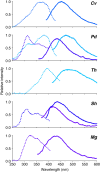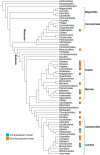Shining a light on UV-fluorescent floral nectar after 50 years
- PMID: 38796543
- PMCID: PMC11128001
- DOI: 10.1038/s41598-024-62626-7
Shining a light on UV-fluorescent floral nectar after 50 years
Abstract
Nature is aglow with numerous captivating examples of UV-fluorescence in the animal kingdom. Despite a putative role as a visual signal, exploration of UV-fluorescence in plants and its role in plant-animal interactions is lagging in comparison. Almost 50 years ago, UV-fluorescence of floral nectar, a crucial reward for pollinators, was reported for 23 flowering plant species. Since this intriguing discovery, UV-fluorescent nectar has only seldom been addressed in the scientific literature and has not been scrutinized in a phylogenetic or ecological context. Here, we report the prevalence of vibrant UV-fluorescent floral nectar across the family Cleomaceae, including the first photographic documentation in vivo colour for flowering plants. Though Cleomaceae flowers are morphologically diverse varying in colour, nectary prominence, and nectar volume, UV-fluorescent floral nectar may be a ubiquitous characteristic of the family. Fluorescence spectra show that the identity and number of fluorescent compounds in floral nectar may differ among Cleomaceae species. As Cleomaceae pollinators range from insects to bats and birds, we suggest that the UV-fluorescent floral nectar not only functions as a visual cue for the diurnal pollinators but also for the nocturnal/crepuscular pollinators in low light settings.
© 2024. The Author(s).
Conflict of interest statement
The authors declare no competing interests.
Figures






Similar articles
-
ATLANTIC POLLINATION: a data set of flowers and interaction with nectar-feeding vertebrates from the Atlantic Forest.Ecology. 2022 Feb;103(2):e03595. doi: 10.1002/ecy.3595. Epub 2022 Jan 12. Ecology. 2022. PMID: 34807455
-
Floral nectary, nectar production dynamics and chemical composition in five nocturnal Oenothera species (Onagraceae) in relation to floral visitors.Planta. 2017 Dec;246(6):1051-1067. doi: 10.1007/s00425-017-2748-y. Epub 2017 Aug 4. Planta. 2017. PMID: 28779217 Free PMC article.
-
First record of bat-pollination in Merremia (Convolvulaceae).Plant Biol (Stuttg). 2025 Jun;27(4):592-601. doi: 10.1111/plb.70016. Epub 2025 Apr 3. Plant Biol (Stuttg). 2025. PMID: 40181223
-
Secondary compounds in floral rewards of toxic rangeland plants: impacts on pollinators.J Agric Food Chem. 2014 Jul 30;62(30):7335-44. doi: 10.1021/jf500521w. Epub 2014 May 15. J Agric Food Chem. 2014. PMID: 24766254 Review.
-
The Genetic Control of Nectary Development.Trends Plant Sci. 2021 Mar;26(3):260-271. doi: 10.1016/j.tplants.2020.11.002. Epub 2020 Nov 25. Trends Plant Sci. 2021. PMID: 33246889 Review.
Cited by
-
In the nectar, there are answers: exploring the intersection of colored nectars and reactive oxygen species in manipulating pollinator behavior.New Phytol. 2025 May;246(3):901-910. doi: 10.1111/nph.70031. Epub 2025 Mar 20. New Phytol. 2025. PMID: 40114421 Free PMC article. Review.
References
-
- Willmer P. Pollination and Floral Ecology. Princeton University Press; 2011.
-
- Giurfa M, Núñez J, Chittka L, Menzel R. Colour preferences of flower-naive honeybees. J. Comp. Physiol. A. 1995;177:247–259. doi: 10.1007/BF00192415. - DOI
-
- Gerl EJ, Morris MR. The causes and consequences of color vision. Evol.: Educ. Outreach. 2008;1:476–486.
MeSH terms
Substances
Grants and funding
LinkOut - more resources
Full Text Sources
Research Materials

